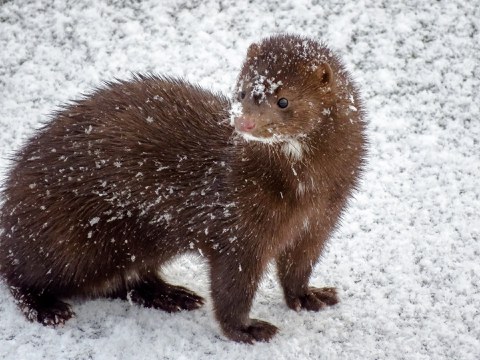03.09.2024
Tierisch Reich: Politik, Pandemie und Pelz – Das Ende einer dänischen Industrie

Nach einer bis heute umstrittenen Entscheidung der dänischen Regierung im Jahr 2020, wurden alle 17 Millionen Nerze gekeult, die in dänischen Pelzfarmen gezüchtet wurden. Damit sollte die Ausbreitung von Covid-19 verhindert werden. Diese Zäsur leitete den Untergang der milliardenschweren dänischen Nerzindustrie ein.
Im Jahr 2020 schockierte die dänische Regierung mit einer drastischen Entscheidung: Wegen eines Covid-19 Ausbruchs in den Nerzfarmen Dänemarks wurden alle 17 Millionen dänischen Nerze gekeult. Das sollte vor allem die Verbreitung und Mutation des Virus eindämmen. Die Nerzzucht war dann bis Anfang 2023 verboten. Damit einher geht der Verlust der sechstgrößten Industrie Dänemarks mit einem Wert von 2,5 Mrd. DKK (335 Mio. USD) 1, 2. Innerhalb des Agrarsektors hatte die Nerzpelzproduktion einen Anteil von 11,3 % am Gesamtexport 3. Neben den beträchtlichen Auswirkungen auf die Wirtschaft, schlug der Fall auch große Wellen in Politik und Gesellschaft: Da die Keulung juristisch nicht zu rechtfertigen war, sah sich der Premierminister gezwungen, kurzfristig Neuwahlen einzuberufen, was sogar einen Regierungswechsel nach sich zog 4.
In Dänemark hat die Nerzzucht eine lange Geschichte 5. Mit über 750 Farmen ist Dänemark der zweitgrößte Produzent von Nerzfellen weltweit und produzierte im Jahr 2019 etwa 36% aller Nerzpelze 6, 7.
Eine wichtige Rolle für den Erfolg des dänischen Nerzpelzes war die Copenhagen Fur Company, welche Farmen und Preisentwicklung beaufsichtigte. Pro Saison produzierten die Nerzfarmen zusammen 25-30 Millionen Nerzfelle 8. Da die Nerzproduktion in Dänemark ein so hochproduktiver Wirtschaftszweig ist, wurde sie als einer der 29 dänischen Kompetenzcluster anerkannt 9.
Nach der Covid-19 bedingten Anordnung zur Keulung aller Nerze, bot die dänische Regierung der Industrie ein „Entschädigungspaket mit zwei Optionen“ an, um die wirtschaftlichen Auswirkungen zu kompensieren. „1) wirtschaftlicher Winterschlaf (der Staat trägt die Unterhaltskosten) oder 2) Abgabe von Produktionskapazitäten und Vermögenswerten an den Staat und Erhalt einer Entschädigung“ 6. Die Finanzhilfe von insgesamt 3 Mrd. USD läuft bis 2030 10. Von den 778 Betrieben entschied sich die Mehrheit für die zweite Option, und nur dreizehn Züchter blieben übrig. Nach der Keulung sank die Produktion von Rohnerzfellen um 25 % und der weltweite Handel mit Rohfellen ging um 30 % zurück 11. Die Gesamtzahl der produzierten Nerzfelle sank von 113 Millionen im Jahr 2014 auf 17 Millionen im Jahr 2022. In den Jahren, in denen das Verbot in Dänemark gilt (2020-22), hat sich die Zahl der weltweit gezüchteten Nerze halbiert 12.
Im Januar 2023 wurde das Verbot der Pelzproduktion aufgehoben, aber seine Auswirkungen sind immer noch präsent: Equipment und Produktionsstätten der Nerzproduktion sind so speziell, dass sie außerhalb dieser Branche kaum Wert haben. Die Produktionsstätten befanden sich in ländlichen Gebieten, in denen die Arbeitslosigkeit hoch ist, so dass viele Angestellte aus der Pelzzucht Schwierigkeiten haben könnten, in ihrer Region einen neuen Arbeitsplatz zu finden 8. Während die Landwirte darüber nachdachten, wie sie sich von diesem verheerenden Verlust erholen könnten, wuchs die Debatte über ein generelles Verbot der Pelzproduktion. In mehreren EU-Staaten ist sie bereits verboten, so auch in Deutschland 13. Trotz der Konfrontation mit PETA sieht es so aus, als sei die EU noch nicht bereit für ein Verbot der Pelzproduktion. Die ESFA muss bis März 2025 ein wissenschaftliches Gutachten erstellen, und die Kommission wird sich nicht vor März 2026 äußern 14. Damit hat Dänemark noch zwei Jahre Zeit, um über die Zukunft einer viel umstrittenen Industrie zu entscheiden.
7 Danish Agriculture & Food Council. (2019). Denmark – a Food and Farming Country Facts &
Figures Brochure.
Sophie Merz, Übersetzung Nele Kheim
Issue 26 (PDF)
